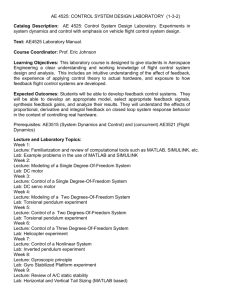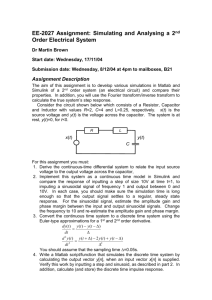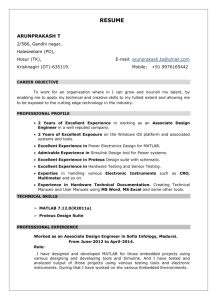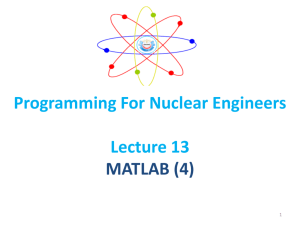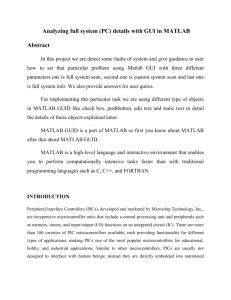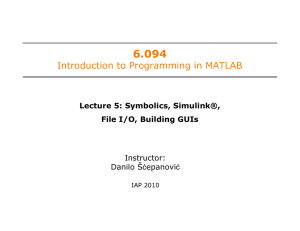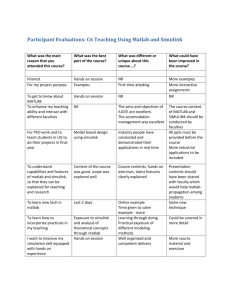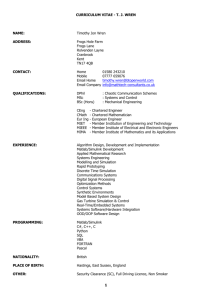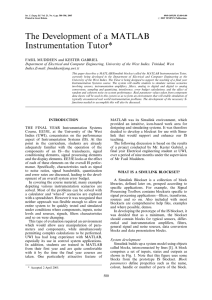COURSE TITLE CONTEMPORARY TECHNICAL PROGRAM
advertisement
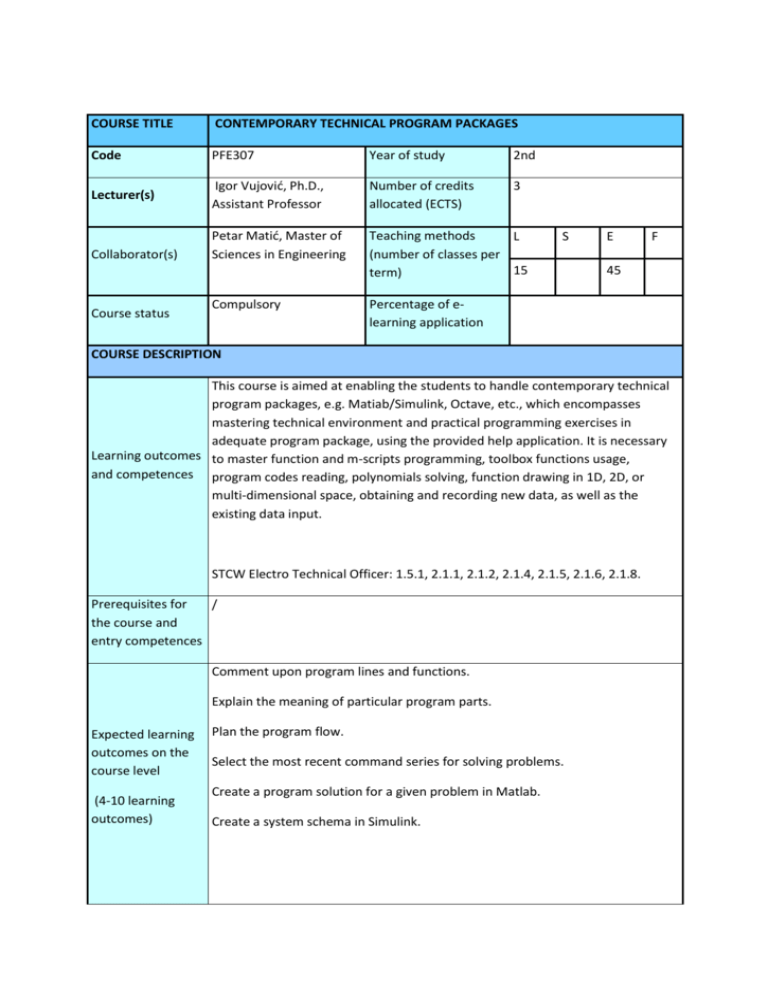
COURSE TITLE CONTEMPORARY TECHNICAL PROGRAM PACKAGES Code PFE307 Year of study 2nd Lecturer(s) Igor Vujović, Ph.D., Assistant Professor Number of credits allocated (ECTS) 3 Petar Matić, Master of Sciences in Engineering Teaching methods L (number of classes per 15 term) Collaborator(s) Course status Compulsory S E F 45 Percentage of elearning application COURSE DESCRIPTION This course is aimed at enabling the students to handle contemporary technical program packages, e.g. Matiab/Simulink, Octave, etc., which encompasses mastering technical environment and practical programming exercises in adequate program package, using the provided help application. It is necessary Learning outcomes to master function and m-scripts programming, toolbox functions usage, and competences program codes reading, polynomials solving, function drawing in 1D, 2D, or multi-dimensional space, obtaining and recording new data, as well as the existing data input. STCW Electro Technical Officer: 1.5.1, 2.1.1, 2.1.2, 2.1.4, 2.1.5, 2.1.6, 2.1.8. Prerequisites for / the course and entry competences Comment upon program lines and functions. Explain the meaning of particular program parts. Expected learning outcomes on the course level (4-10 learning outcomes) Plan the program flow. Select the most recent command series for solving problems. Create a program solution for a given problem in Matlab. Create a system schema in Simulink. Matlab and Octave: introductory presentation, possiblities, application, and readng material. Variable types and singling out its parts from the whole. Basic mathematical operations derivation, relation operators, matrix operations. Polynomials and polynomial operations. Analitical operations in Matlab (symbolic variables). Data storage and input of various formats and records presentations. Results presentation in 1D, 2D, and 3D. Toolboxes and functions usage. The application of Laplace’s transformation. Course contents elaborated in accordance with the syllabus Definition of transfer function and system temporal response; defining poles, zeros, and residiums. Program flow control. Simple Matlab programs (m-scripts) and functions. Creating programs and functions of one’s own. Matlab programming: advanced possiblities. Simulink: presentation and operating principles, basic elements. Modeling, adjusting simulation parameters, simulation results presentation ☒ lectures ☐ independent tasks ☐ seminars and workshops ☐ multimedia ☐ exercises ☒ laboratory Teaching methods ☐ on line entirely ☐ work with supervisor ☐ miscellaneous e-learning ☐ field tasks Student obligations Class attendance 0,5 Experimental work Student monitoring and supervision Essay Research Practical work Paper Program code / model creation Seminar paper 1,5 1 (Other) Preliminary examinations Oral examination (Other) Written examination Project (Other) Evaluation and Class attendance: 15 points assessment in class Computer practice: 20 points and final examination Independent creation of a program code / model: 65 points Title Recommended reading (available in library and 1. Matlab Tutorial and Help Desk, through the media) www.mathworks.com Supplementary reading Number of copies in the library Availability through other media WEB 2. T. Petković: Kratke upute za korištenje MATLAB-a, FER, 2005. WEB 3. I. Vujović: Zabilješke s predavanja o naprednim funkcijama i primjenama, 2012. WEB 1. Ž. Ban, J. Matuško, I. Petrović, Uvod u programski sustav Matlab, FER, 2010. ili prezentacija on-line: http://www.tel.fer.hr/_download/repository/matlab_dio1.pdf 2. Uvod u Simulink, on-line: http://www.tel.fer.hr/_download/repository/ matlab_pred_2_simulink%5b1%5d.pdf 3. S. T. Karris, Signals and Systems with MATLAB® Applications, Orchard Publications, 2003, ISBN 0-9709511-8-3 4. MATLAB, The Language of Technical Computing, The MathWorks, Inc., 2002. 5. S.T. Karris, Introduction to Simulink with Engineering Applications, Orchard Publications, 2006 6. R. Priemer, Matlab for Electrical and Computer Engineering Students and Proffesionals with Simulink, Scitech Publishing, Edison, NJ, 2013. Quality assessment University questionnaire, student evidence list, Faculty surveillance ensuring the determined learning outcomes Other (according to the proponent)
